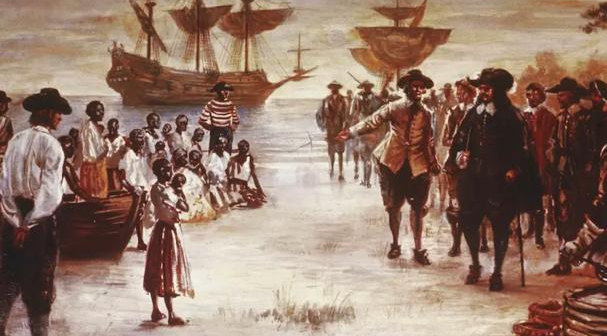Exactly 405 years ago today, the first batch of African slaves were transported to Jamestown by the British. This marked the beginning of their excruciating pains. Justice, decency and human dignity was never accorded them.
Around August 20, 1619, “20 and odd” Angolans, who were captured by the Portuguese, arrived in the British colony of Virginia, where they were purchased by English colonists. The precise date of their arrival remains uncertain, with historical records indicating their ship landed “in the latter part of August.” This date is often used to signify the beginning of two and a half centuries of slavery in North America.
The Virginia Colony, established at Jamestown in 1607, had about 700 residents by 1619. The first group of enslaved Africans came ashore at Point Comfort, now known as Fort Monroe. Details about most of their names and the exact number who stayed at Point Comfort have been lost over time, but the events of their capture and journey are well-documented.
Initially seized by Portuguese forces, these individuals were taken from the Kongo and Ndongo kingdoms and marched to the port of Luanda, today’s capital of Angola. They were placed aboard the San Juan Bautista, which embarked for Veracruz in New Spain. During the voyage, about 150 of the 350 captives died. Near its destination, the ship was raided by two privateer vessels, the White Lion and the Treasurer, which seized up to 60 of the enslaved individuals. The White Lion eventually docked at Point Comfort in Virginia, where it traded some of the captives for supplies on August 20, 1619.
While these individuals were technically classified as indentured servants—a status that typically allowed for eventual freedom after fulfilling a work contract—it’s evident they were forced into servitude, fitting the Universal Declaration of Human Rights’ definition of enslaved people. Although records suggest that some later gained their freedom, their initial conditions align more closely with enslavement.
This event signaled a new phase in the trans-Atlantic slave trade, which had begun in the early 1500s and persisted until the mid-1800s. It led to the displacement of about 12 million Africans, sending approximately 5 million to Brazil and over 3 million to the Caribbean. While the total number of Africans brought directly to mainland North America was relatively modest at about 400,000, their labor and that of their descendants were instrumental to the development of the British colonies and, subsequently, the United States.
Among those who arrived on the White Lion were Antonio and Isabella, who became “servants” to Captain William Tucker, the commander at Point Comfort. Their son, William, holds the distinction of being the first African child born in America. Born into freedom according to the laws of that time, the legal landscape would soon shift as slavery became more formally entrenched in the following decades.


























































